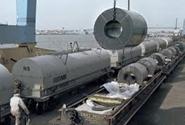Shipping and Logistics

Shipping Demand Weakens in October
Written by Sandy Williams
October 21, 2016
With the end of October at hand, it is time for SMU to take another look at shipping conditions around the U.S.
Seaborne
MID-SHIP is seeing improvement in freight rates and fuel prices and an increase in period chartering activity for seaborne cargo. A surge in coal pricing in the past few weeks has resulted in a spike in rates in the Panama freight market. Handy Size and Supra freight markets are also showing rate increases while the Cape Size market is beginning to soften.
The Baltic Dry Index registered 842 on Oct. 21, continuing its descent over the past week and possibly signaling that the shipping industry has seen its last surge in rates for the year.
River
The September increase in spot barge rates for grain exports is not holding and in the second half of October rates have been uncharacteristically low, said MID-SHIP. A combination of competition for cargo by barges and a weak cash market for grain has led to the softening in rates.
River conditions currently are in good shape other than some seasonal high water levels on the Upper Mississippi. The work on the Industrial Locks in New Orleans is continuing with reopening scheduled for December 5. Cooler weather is beginning to result in navigation delays due to high seas and high winds along the coastline and fog, says MID-SHIP.
Trucking
DAT Trendlines reports that load posts slowed on the West coast during the week of Oct. 9-15. Volumes and rates increased in the Southeast after Hurricane Matthew. Nationally spot market loads increased 5.6 percent during the week while capacity increased 0.5 percent
The spot market for flatbed rates, however, was unchanged after the hurricane. Load posts for flatbed trucks jumped 10 percent in the week following Matthew, increasing the load to-truck-ratio by 10 percent to 14.7 loads per truck. As of Oct. 16 the U.S. on-highway diesel rate was $2.481 per gallon, up from $2.389 per gallon on Oct. 3.
The American Trucking Association reported volatility in September with the For-Hire Truck Tonnage Index contracting 5.8 percent in September after rising 5 percent in August.
“Volatility this year continued again in September with the large drop after a significant increase in August,” said ATA Chief Economist Bob Costello. “The changes we’re seeing in typical seasonal trends are making it difficult to discern any real or clear trend in truck tonnage.
“Adjusting for the larger ups and downs this year, as well as talking with many fleets, I currently see a softer than normal freight environment, which is likely to continue until the inventory correction is complete. Looking ahead, the slow growth economic environment does not suggest that significantly stronger truck tonnage numbers are in the near term either,” he said.
Rail
The Association of American Railroads reported U.S. rail traffic in the week ending October 15, 2016 was 531,936 carloads and intermodal units, down from 4.2 percent in the same week in 2015. Carloads were down 5.1 percent to 262,702 carloads and intermodal volume was down 2.2 percent to 269,234 containers and trailers.
Cass Freight Index
Cass Freight Index offered disappointing data in September indicating weakness in most shipping modes. The shipments index declined -0.4 percent month over month to 1.111 and was down 3.1 percent year-over-year. Rail volumes were one of the weaker components of the index. Cass asserts that trucking is the more “reliable read on the pulse of the domestic economy.” The focus in trucking is on number of loads (rather than tonnage) and has contacted year-over-year in four of the last six months.
Said Cass, “September data is once again signaling that overall shipment volumes (and pricing) continued to be weak in most modes, with increased levels of volatility as all levels of the supply chain (manufacturing, wholesale, retail) continue to try and work down inventory levels. That said, there have been a few areas of growth, mostly related to e-commerce, with lower levels of expansion being experienced in transit modes serving the auto and housing/construction industries.”
The expenditures index was “a glimmer of potential hope,” said Cass. The expenditures index rose 5.2 percent in September from August to 2.396. Compared to September 2015, the index contracted 3.8 percent which was less than four other months in 2016. “We see this increase as a result of the steady increase in the price of fuel over the last six months and not the increase in pricing power of any single mode,” said Cass.
About the Index: The Cass Freight Index represents monthly levels of shipment activity, in terms of volume of shipments and expenditures for freight shipments.

Sandy Williams
Read more from Sandy WilliamsLatest in Shipping and Logistics

Wittbecker on Aluminum: US-China trade war clobbers cross-Pacific trade
Container shipping lines have sharply increased blank sailings on Transpacific routes in response to escalating trade tensions between the US and China.

Volvo plans to lay off up to 800 workers at US truck plants
The company cited uncertainty about freight rates and demand, regulatory changes and the impact of tariffs.

Trump signs executive order aimed at making US shipbuilding ‘great again’
President Trump on Wednesday signed an executive order meant to breathe new life into American shipbuilding and curb Chinese dominance in the sector.

Great Lakes iron ore trade fell again in March
Recall that shipments also saw a sharp decline in January.

Longshoremen ratify contract with maritime alliance
Nearly 99% of ILA members voted in favor of a new labor deal with the United States Maritime Alliance that covers workers at ports on the Atlantic and Gulf coasts.
